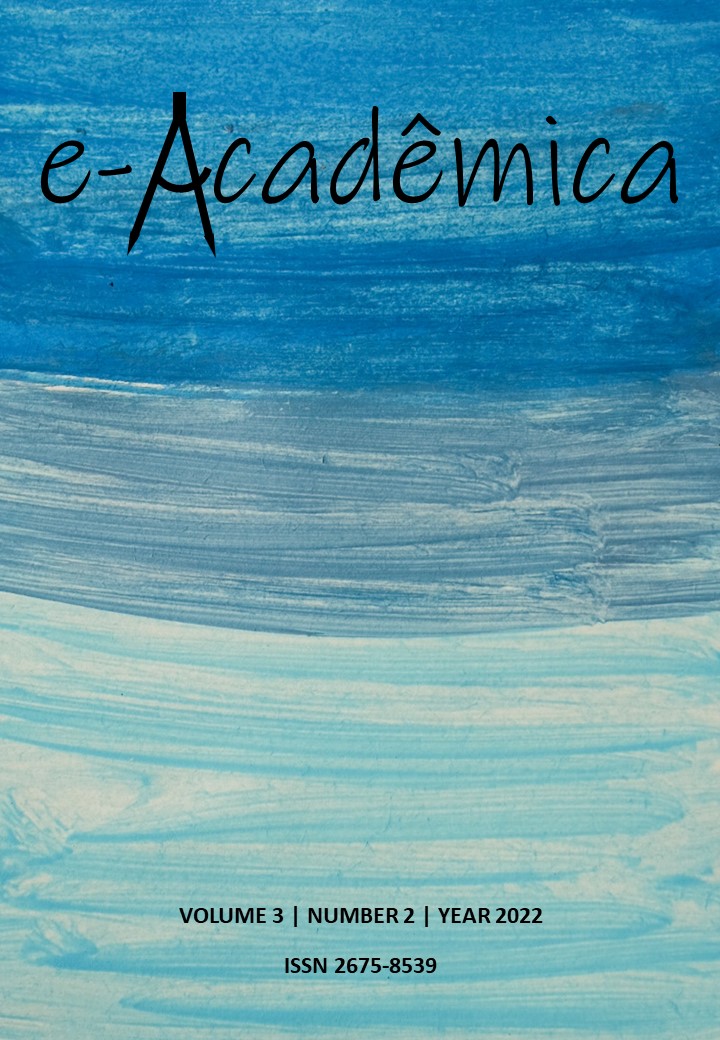Systematic review of the assessment of placental insufficiency
DOI:
https://doi.org/10.52076/eacad-v3i2.201Keywords:
Placenta; Insuficiência placentária; Gestação de risco.Abstract
Introduction: Placental changes are related to unfavorable outcomes such as placental infarction, chorioamnionitis and even fetal death, and may be associated with changes in the embryo and fetus with late repercussions, including prematurity. The objective of this work is to develop an assessment of placental function to assess pregnant women at risk of placental insufficiency. Methods: Systematic literature review based on ten works chosen through a search on research platforms, using specific terms such as placental insufficiency and placenta. Results: Placental insufficiency is strictly related to maternal conditions such as Gestational Diabetes mellitus, Systemic Arterial Hypertension, infectious processes, Collagenosis, Nephropathies, Thrombophilia, Cyanotic Heart Diseases. Hypertensive disease is responsible for the greatest cause of maternal death. Case studies revealed that ultrasound associated with Doppler velocimetry of maternal, fetal and fetal-placental arteries showed great specificity in the evaluation of cases of placental insufficiency. The anatomohistopathological study is important to evaluate acute and chronic perinatal insults, specific etiologies related to pregnancy, specific pathologies of multiple pregnancies and change the management to seek better results and prognoses. Conclusion: The studies demonstrated effectiveness in preventing negative outcomes and in the early recognition of placental insufficiency, associated with early intervention, exemplified in the use of aspirin by hypertensive pregnant women starting below 16 weeks of gestation. This evaluation Macroscopic examination should be performed showed that performing ultrasound associated with Doppler velocimetry has a greater negative predictive value to screen these cases. In the immediate postpartum period. The anatomohistopathological examination has wide maternal, fetal/neonatal and placental indications.
References
Ariel I., Anteby E., Hamani Y. & Redline R. W. (2004). Placental pathology in fetal thrombophilia. Human pathology. 35(6), 729 - 731. https://doi.org/10.1016/j.humpath.2004.02.010.
Artico G. L., Madi, J. M., Godoy, A. E. G., Coelho, C. P., Rombaldi, R. L. & Artico, G. R. (2009). Alterações histopatológicas em placentas humanas relacionadas às síndromes hipertensivas. Revista Brasileira de Ginecologia e Obstetrícia. 31(1):10-16.
Carlson, B.M. (2014). Embriologia humana e biologia do desenvolvimento. (5a ed.), Elsevier.
Colella, M., Frérot, A., Novais, A.& Baud, O. (2018). Neonatal and Long-Term Consequences of Fetal Growth Restriction. Current Pediatric Reviews. 14(4), 212-218(7). https://doi.org/10.2174/157339631466618071211453.
Galvão, M. C. B., & Ricarte, I. L. M. (2019). Revisão sistemática da literatura: conceituação, produção e publicação. LOGEION: Filosofia da informação. 6(1), 57-73. https://doi.org/10.21728/logeion.2019v6n1.p57-73.
Gordijn, S. J., Beune, I. M., Thilaganathan, B., Papageorghiou, A., Baschat, A. A., Baker, P.N., Silver, R.M., Wynia, K., & Ganzevoort, W. (2016). Definição consensual de restrição ao crescimento fetal: um procedimento de Delfos.Ultrassom em obstetrícia & ginecologia: o diário oficial da Sociedade Internacional de Ultrassom em Obstetrícia e Ginecologia,48(3), 333-339. https://doi.org/10.1002/uog.1588.
Higgins, M, Mcauliffe, F. M. & Mooney, E. E. (2011). Associações clínicas com um diagnóstico placentário de maturação vilosa tardia: um estudo retrospectivo. Pediatric and Developmental Pathology; 14:273.
Huynh, J., Dawson, D., Roberts, D., Bentley-Lewis. (2015). Uma revisão sistemática da patologia placentária no diabetes mellitus materno. Placenta, 36:101.
Kramer, M. S., Usher, R. H., Pollack, R., Boyd M., Usher, S. (1997). Etiologic determinants of abruptio placentae. Obstetrics & Gynecology; 89:221-6.
Kierszenbaum A. L. (2012). Histologia e Biologia Celular: uma introdução à patologia, 3a. ed., Editora Elsevier, Rio de Janiero, Brasil.
Martins, D. R. S. (2015). Restrição de crescimento intrauterino: estado da arte na previsão e prevenção. Instituto de ciências biomédicas Abel Salazar, Porto.
Mccowan, L. M., Figueras, F., & Anderson, N. H. (2018). Evidence-based national guidelines for the management of suspected fetal growth restriction: comparison, consensus, and controversy. American journal of obstetrics and gynecology,218(2S), S855–S868. https://doi.org/10.1016/j.ajog.2017.12.004.
Moreira Neto, A. R., Córdoba, J. C. M., & Peraçoli, J. C. (2011). Etiologia da restrição do crescimento intrauterino (RCIU). Com. Ciências Saúde. 22(1): 521-530.https://bvsms.saude.gov.br/bvs/artigos/etiologia_restricao_crescimento.pdf.
Ohyama, M., Itani, Y., Yamanaka, M., Goto, A., Kato, K., Ijiri, R. & Tanaka, Y. (2004). Maternal, neonatal, and placental features associated with diffuse chorioamniotic hemosiderosis, with special reference to neonatal morbidity and mortality. Pediatrics; 113:800.
Pels, A., Beune, I. M., Van Wassenaer-Leemhuis, A. G., Limpens, J., & Ganzevoort, W. (2020). Early-onset fetal growth restriction: a systematic review on mortality and morbidity. Acta Obstet Gynecol Scand, 99(2), 153-166. https://doi.org/10.1111/aogs.13702
Pereira, D. D. S., Magalhães, A. L. C., Jesús, N. R., & Trajano, A. J. B. (2014). Restrição de Crescimento Intrauterino. Revista HUPE, 13(3), 32-39. http://www.e-publicacoes.uerj.br/index.php/revistahupe/article/view/12135.
Ramalho, W.S. (2012). Desvios de crescimento intra-uterino: aspectos anatomopatológicos macroscópicos placentários na gestação de alto risco. Tese de mestrado na enfermagem. Universidade Federal de Goiás.
Salge, A. K. M., Silva, R.C.R., Guimarães, J. V., Ramalho, W. S., Abdalla, D. R. & Abdalla, G. K. (2017). Relação entre os aspectos clínicos, placentários, obstétricos e neonatais e o crescimento intrauterino na gestação de alto risco. Texto & Contexto – Enfermagem. 26 (02).
https://doi.org/10.1590/0104-07072017005520015.
Zanette, N.V., Costa, A.Z.D., & Corrêa, T.R.K. (2016). Caracterização de gestantes com diagnóstico de Restrição de Crescimento Intrauterino internadas em um hospital do Sul do Brasil. Revista AMRIGS; 60(3): 214-219.https://pesquisa.bvsalud.org/portal/resource/pt/biblio-832342.
Downloads
Published
How to Cite
Issue
Section
License
Copyright (c) 2022 Camila Siqueira da Silva; Diego Augusto dos Santos Silva; Herick Rangel do Nascimento; Magno Pereira Prado

This work is licensed under a Creative Commons Attribution 4.0 International License.
Autores que publicam nesta revista concordam com os seguintes termos:
1) Autores mantém os direitos autorais e concedem à revista o direito de primeira publicação, com o trabalho simultaneamente licenciado sob a Licença Creative Commons Attribution que permite o compartilhamento do trabalho com reconhecimento da autoria e publicação inicial nesta revista.
2) Autores têm autorização para assumir contratos adicionais separadamente, para distribuição não-exclusiva da versão do trabalho publicada nesta revista (ex.: publicar em repositório institucional ou como capítulo de livro), com reconhecimento de autoria e publicação inicial nesta revista.
3) Autores têm permissão e são estimulados a publicar e distribuir seu trabalho online (ex.: em repositórios institucionais ou na sua página pessoal) a qualquer ponto antes ou durante o processo editorial, já que isso pode gerar alterações produtivas, bem como aumentar o impacto e a citação do trabalho publicado.










